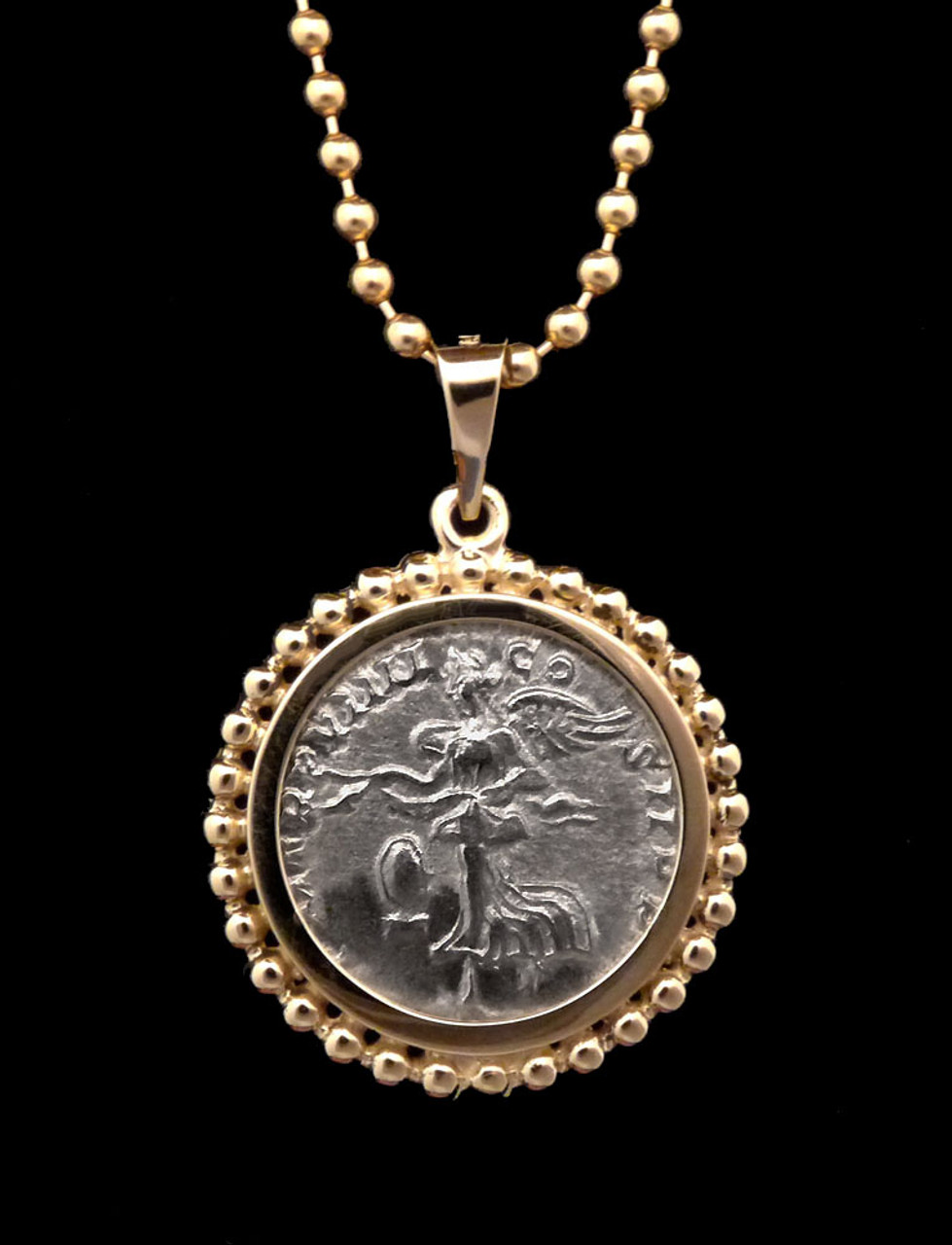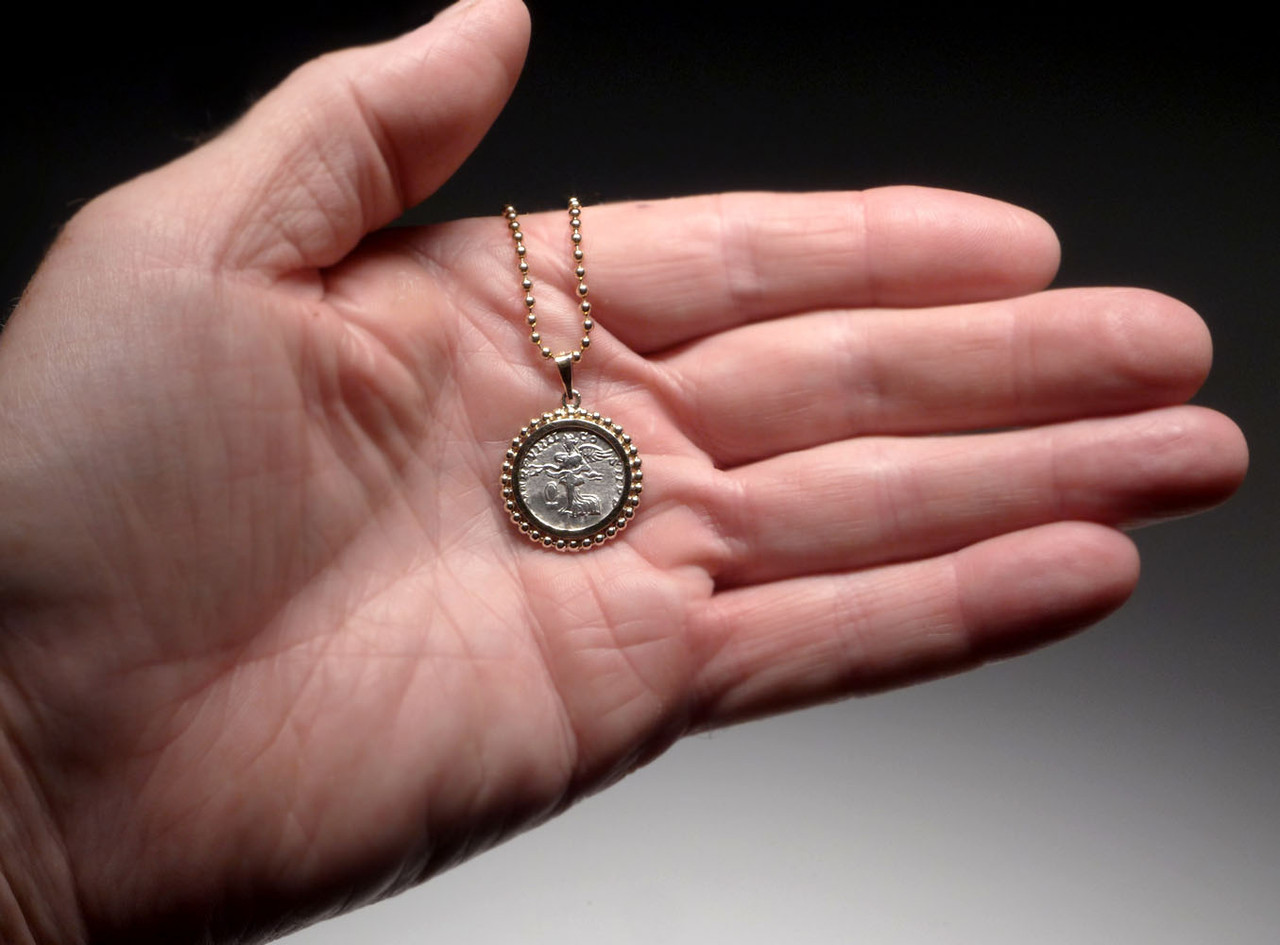Product Description
This is one of the few times I have had the opportunity to offer such a splendid ancient Roman Victory angel coin with such beauty and exceptional preservation! This 14KT yellow gold beaded pendant features a genuine ancient Roman silver denarius coin mounted with the reverse side out. It shows an incredible depiction of the Roman goddess VICTORIA, the goddess of VICTORY and TRIUMPH! This stunning pendant would make a perfect gift to commemorate anyone's personal victory, a successful completion of one's military tour of duty, or as an unforgettable token to wear in an uncertain world to welcome the accompaniment of VICTORIA (VICTORY) into one's life! She is shown floating to the left with open wings, flowing robes, and holding an open wreath in her outstretched arm. To the left of her is an army shield set on a base. The ancient die engraver was able to impart exceptional detail. A well-centered strike on the coin makes for nothing short of a miniature ancient masterpiece!
This ancient Roman silver denarius coin was minted under the rule of emperor Septimius Severus, and dates from 193 AD to 211 AD. The photos above show the emperor's profile on the obverse of the coin which is the back side of the pendant, as I wanted to feature the angel facing out on the display side.
*** Chain is not included but may be purchased additionally, at the link below
GUARANTEE: ALL PURCHASES ACCOMPANIED WITH A WRITTEN GUARANTEE OF AUTHENTICITY
SETTING: 14KT YELLOW GOLD
COIN: SILVER DENARIUS
COIN AGE: 193 - 211 A.D.
DIMENSIONS: .85" or 21 mm overall diameter
:::: Includes Gift Box
:::: Includes CERTIFICATE OF AUTHENTICITY / HISTORY SHEET
ADD THE DISPLAYED MEDIUM BEAD CHAIN
MORE ANCIENT ROMAN COIN JEWELRY
HISTORY
VICTORIA in ancient Roman religion, was the personified goddess of victory. She is the Roman equivalent of the Greek goddess Nike, and was associated with the goddesses Bellona and Roma. She was adapted from the Sabine agricultural goddess Vacuna and had a temple on the Palatine Hill. The goddess Vica Pota was also sometimes identified with Victoria. Victoria is often described as a daughter of Pallas and Styx, and as a sister of Zelus, Kratos, and Bia.
Unlike the Greek Nike, the goddess Victoria (Latin for "victory") was a major part of Roman society. Multiple temples were erected in her honor. Victoria was normally worshiped by triumphant generals returning from war. Victoria was a symbol of victory over death and determined who would be successful during war.
Victoria appears widely on Roman coins, jewelry, architecture, and other arts. She is often seen with, or in a chariot, as in the late 18th-century sculpture representing Victory in a quadriga on the Brandenburg Gate in Berlin, Germany; "Il Vittoriano" in Rome has two. Nike or Victoria was the charioteer for Zeus in his battle to overtake Mount Olympus. She was often depicted holding or bearing objects associated with victory, such as the laurel wreath and/or palm branch.
Winged figures, very often in pairs, representing victory and referred to as winged victories, were common in Roman official iconography, typically hovering high in a composition, and often filling spaces in spandrels or other gaps in architecture. These represent the spirit of victory rather than the goddess herself. Pairs of winged victories continued to appear after Christianization of the Empire and gradually evolved into depictions of Christian angels.
 US Dollars
US Dollars
 AUD
AUD
 CAD
CAD
 POUNDS STERLING
POUNDS STERLING








